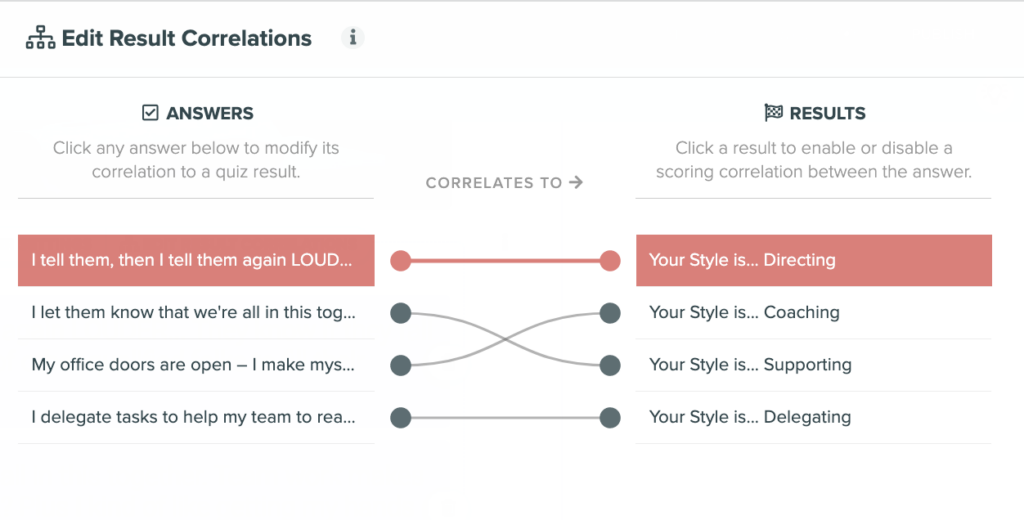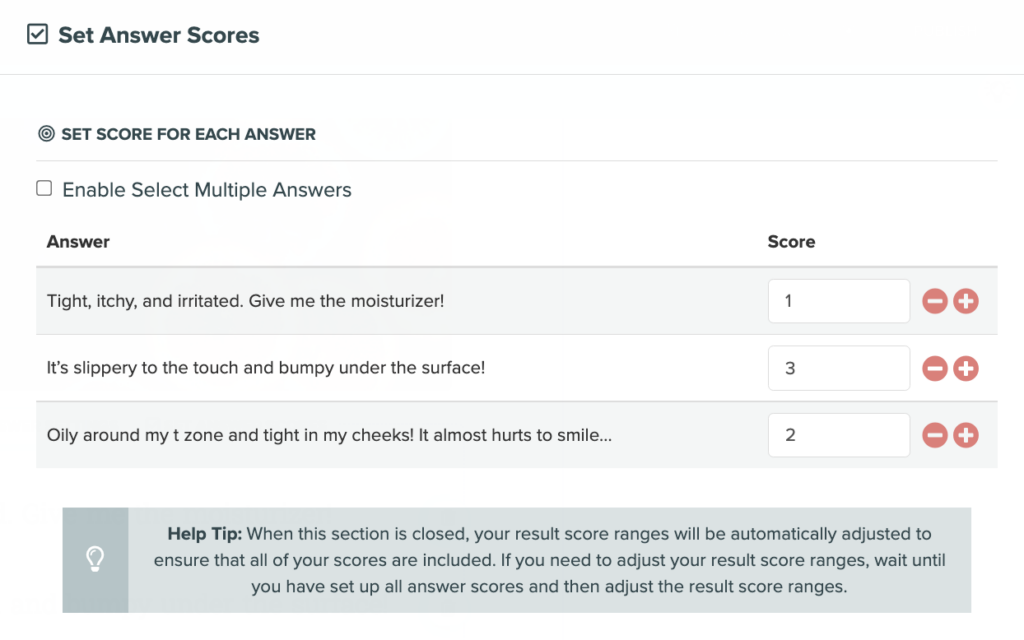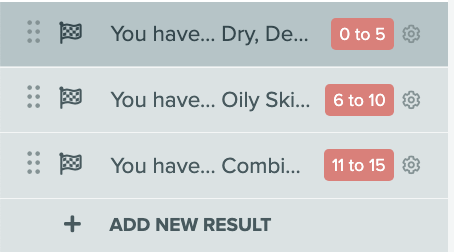The optimal number of questions on a quiz is seven questions. More broadly you can have 5-10 questions and don’t have to be strict if you need more or less than seven. The reason why we recommend seven questions is that your quiz takers will spend approximately two minutes answering those seven questions. That is long enough to where they will be very engaged and curious to see their results but not too long to where they will leave because the quiz has too many questions.
Seven questions maximizes your quiz opt-ins because it gets people curious and anticipating their quiz results.
Now let’s work through how you actually go about writing those seven questions and crafting a quiz that converts cold traffic into leads at a high rate.
Step 1: Lay out your quiz results
In order to know what your quiz results are, you must first know who the quiz is for. Once you know who the quiz is for, you will break down the quiz audience into 3-4 categories and those will be your quiz results. After you have your quiz results identified then your quiz questions will guide people to the right result based on how they answer the quiz questions.
Let’s go through the process for identifying who your quiz is for. The easiest way to do this is by looking at the common quiz titles that work well and you can choose which one fits your needs.
When crafting a quiz title – it is about helping your customers find an answer to what is already on their minds. Every title we will talk about here intends to meet your quiz takers where they are and help them move through a problem that is bothering them.
The product/solution finder
This could be to find a product or service that solves a problem. Which would be a What type of “Blank” is Right for You? quiz. Which is very common for E-Commerce. Think about the “Which lipstick is right for you?” type of quizzes you see on cosmetics sites all the time.
For a product/solution finder quiz, the categories you will identify are the products/solutions themselves. We recommend choosing 3-4 of these to have as your quiz results. For example if you sell skin care products, you can recommend three particular items as your results, or batch people into skin types and recommend 3-4 products per skin type.
The personality discovery quiz
The “What Type of “Blank” are You?” quiz that gives people insight into their personality and then guides them to products/services/solutions that help where they are. This type of quiz is loosely based on the classic personality tests you’ve taken. It puts people into categories based on their preferences and how they show up in the world. This type of quiz capitalizes on the self-actualization desire that every human has.
In this type, your quiz results will be the personality types. Think about your main audience, let’s say it is creative entrepreneurs, so your results will be the 3-4 most common personality types of creative entrepreneurs.
The “Next Step” quiz
For many coaches there is often this question of “What do I need to do next?” In speaking with coaches for entrepreneurs one very common story is that their clients are overwhelmed, burnt out, and just trying to figure out how to get out of their situation. That is where you meet them with a quiz such as “What Does Your Business Need to Grow?” can help answer that question.
For this type, the results of your quiz will be the next steps you identify. Based on your knowledge of your customers, choose 3-4 things people can do to improve their situation and those will be the results of your quiz.
The matchmaker quiz
This one asks “Is “Blank” Right for You?” so for example, “Is Therapy Right for You?” “Do You Need a Web Designer?” “Will This Face Wash Work for You?” This type of quiz works well when you have a specific solution in your offerings and you want people to self-identify if it’s the right answer for them. Quiz takers appreciate a quiz like this because it helps them save time knowing if you are the right answer to their problems.
The results for a matchmaker type quiz will be a determination of whether you are a good fit. Typically there are three options – good fit, not a good fit, potentially a good fit. Those will be the results of your quiz.
Step 2: write 5-10 questions to find out which result someone should get
Once you know your 3-4 quiz results based on the exercise in step 1, you will write questions that lead to one of those results. The best way to do this is picturing yourself sitting with a potential new client and you only get seven questions to figure out which of the 3-4 results they should get.
In that way it’s like the game “20 questions” where the person can answer questions and you narrow down their result in your head.
Practically speaking, the way scoring works is either with a personality scoring system or a scored quiz logic system. Let’s look at the two and you can decide which makes sense for your quiz (70% of the time personality scoring is best, 30% of the time scored logic is best).
For the personality scoring system, every question you write will have a number of answer choices equal to the number of results in your quiz. Each answer choice will correlate to one of the results of your quiz. That way when someone is taking your quiz they have an equal chance of getting each quiz result and the quiz result they see will depend on how they answer the quiz questions.
Here is an example from a quiz titled “What’s Your Leadership Style?” and the question is “How do You Make Sure Your Employees Reach Their Goals?” the question has four answer choices, and each each choice correlates to one of the quiz results (The Leadership Styles in this case).The quiz has eight total questions and each question has four answer choices, each correlating to one of the quiz results.
So as someone is going through the quiz, the highest possible number of correlations to any quiz result is 8, since you can only select one answer choice per question on this quiz (you can allow people to select multiple as well). But for this example they can only select one answer choice.
The result shown to the quiz taker will be the one with the most correlations. So let’s say result 1 gets 4, result 2 gets 2, result 3 gets 1 and result 4 gets 1. In that case I would be shown result 1 as my quiz result. Here is what it looks like when you are setting it up inside of interact.

For the scored logic example, it works on a tally system. Each answer choice throughout your quiz has a point value associated with it, and your quiz results are based on what range of points the quiz taker accumulates while answering the quiz questions. This system is most common with quizzes where you are trying to figure out someone’s level or need based on their proficiency in a topic.
It can be used for helping someone figure out which product or service they need, or whether they need your solution at all, depending on how advanced they are in the area you serve. Here is an example of what the points system looks like for each question of the quiz.

And then the results of the quiz are based on how many total points you get, so “0 to 5” is one results “6 to 10” is another, and “11 to 15” is a third.

Conclusion
Hopefully that helps sort out the question of how many questions your quiz should have for maximum conversions, and also how to formulate those questions in the easiest possible way. If you want more personalized assistance with your quiz setup we offer free quiz strategy calls on our website, just go to Interact Quiz Builder and click the “Quiz Strategy Call” button to speak with an expert one-on-one.